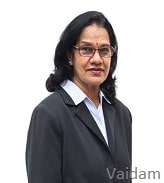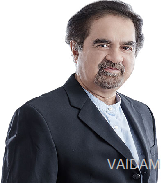Listing approximate price of Angiography and some related procedures. The prices may change depending upon the centers and condition of the patient.
| Treatment name | Cost range |
|---|---|
| Angiography | USD 480 to USD 720 |
| Angioplasty and Stent Placement | USD 5920 to USD 8880 |
| Coronary Artery Surgery | USD 8000 to USD 12000 |
| Cerebral Angioplasty | USD 7200 to USD 10800 |
Your doctor will recommend tests before angiography, including blood tests, MRI, ECG, chest X-ray, or cardiac CT. 10-15% of the total procedure cost is involved in medical tests related to the procedure. The treatment package contains the cost of the tests too.
The pharmacy and medicine bills are included in the package when the patient is in the hospital. On the other hand, if the patient buys medicines outside the hospital, they are not included in the package.
The patient has to rest for four to six hours in the hospital after the procedure is completed and can go home the same day. Sometimes the patient needs to stay in the hospital overnight. They also need follow-up tests, such as ECG, and blood tests, throughout the first year after the angiography.
For patients planning to travel abroad it is useful to know the price in destinations popular with medical travellers. The price for Angiography in different countries is approximately:
Popular Cities in Malaysia for Angiography are:
Listing popular specialists:

Consultant, 38 years of experience

Ambulatory Blood Pressure Monitoring Arrhythmia Surgery Balloon Valvuloplasty Cardiology Consultation Cardiomyopathy

Senior Consultant, 20 years of experience

Internal Medicine and Cardiology.

Senior Consultant, 26 years of experience

Non-Invasive Cardiology, Invasive Cardiology and Interventional Cardiology.

Consultant, 20 years of experience

Valvular Heart Disease Coronary Artery Disease Arrhythmias Heart failure (Acute and Chronic)

Consultant, 20 years of experience

Cardiology / Interventional Cardiology.

Consultant, 35 years of experience

Cardiac examination and treatment with non-invasive and invasive techniques.

Consultant, 40 years of experience

Hypertension, Coronary Artery Disease and Vascular Heart Disease.

Consultant, 50 years of experience

Angina Pectoris Coronary Heart Disease Heart Disorders Peripheral Artery Disease

Dr. Mohd Hamzah bin Kamarulzaman
Senior Resident, 33 years of experience

Aortic Surgery, Ventricular septal defect (VSD) and Atrial septal defect (ASD), Coronary Artery Bypass Surgery and Grafting, Intra - Cardiac Repair, Tetralogy of Fallot, Patent Foramen Ovale, Valve Repair and Replacement

Dr. HJ Nik Isahak Wan Abdullah
Consultant, 30 years of experience

Angina pectoris Atherosclerosis Cardiothoracic diseases/ Cardiovascular disorders Balloon Angioplasty of Coronary Artery Interventional cardiology procedures Coronary angiogram (CAG) Pacemaker Implantation

Consultant, 25 years of experience

Cardiac Assessment Cardiac Rehabilitation Cardiology Consultation Coronary Angiogram Coronary Angioplasty Electrocardiogram (ECG or EKG) Pericardiocentesis Ventriculography

Consultant, 25 years of experience

Coronary intervention Acute myocardial infarction

Consultant, 26 years of experience

Echocardiology Coronary and peripheral interventional procedures

Consultant, 22 years of experience

Optical Coherent Tomography Intravascular ultrasound

Consultant, 30 years of experience

Heart diseases Congestive heart failure Bypass surgery Arrhythmia Angioplasty

Senior Consultant, 20 years of experience

Complex angioplasty Small vessel stenting Chronic total occlusions Percutaneous interventions in diabetics Intravascular ultrasound Aldosterone and autonomic tone in heart failure

Senior Consultant, 30 years of experience

Balloon angioplasty of coronary artery, Coronary angiogram, Echocardiography, IVC Filter Insertion, Intra-aortic balloon insertion, Pacemaker implantation.

Senior Consultant, 40 years of experience

- Echo Cardiography - Coronary Angioplasty - Balloon Valvuloplasty - Cardiovascular Disease - Interventional Cardiology

Dr Mohamed Nazrul bin Mohamed Nazeeb
Consultant, 10 years of experience

- Cardiomyopathy - Pulmonary Hypertension - Valvular Heart Disease - Peripheral Arterial Disease - Pulmonary Embolism

Senior Consultant, 30 years of experience

Ischaemic heart disease hypertension, Heart failure, Arrhythmia, Valvular heart disease and Cardiomyopathy.
Our Services for Angiography in Malaysia
Transparent - Professional - Without Hassles
Angiography is an X-ray procedure that examines blood arteries. Because blood vessels are difficult to see on a standard X-ray, a special dye must be injected into your blood first. This draws attention to your blood vessels, making it easier for your doctor to spot any abnormalities. Angiograms are the X-ray pictures generated during angiography.
Angiography is a procedure that examines the condition of your blood arteries and the flow of blood through them. It can aid in the diagnosis or investigation of a variety of blood vessel issues, including:
Atherosclerosis is a narrowing of the arteries that increases the risk of a stroke or heart attack.
Atherosclerosis of the peripheral arteries – Leg muscles have a lower blood supply.
An aneurysm is a protrusion in the brain.
It can provide pictures of blood vessels in a variety of organs. As a result, angiograms are frequently used to assist doctors in diagnosing disorders affecting the heart, brain, arms, and legs. Angiograms can be used to identify anomalies in the blood vessels, such as weakening blood vessels, plaque deposits, and blood clots.
Angiography comes in a variety of forms, depending on which area of the body is being examined.
The following are examples of common types:
Coronary Angiography - a procedure that examines the heart and blood arteries nearby.
angiography of the brain — a procedure that examines the blood arteries in and around the brain.
Pulmonary Angiography - a procedure that examines the blood arteries that supply the lungs.
Renal Angiography is a procedure that examines the blood arteries that feed the kidneys.
A catheter is a long, thin, flexible tube that is placed into an artery and carefully directed to the location to be studied. When this is done, you may feel some pressing and tugging, but it should not be uncomfortable.
Angiography takes around 30 minutes to 2 hours to complete.
Eight hours before the angiography, don't eat or drink anything. Make arrangements for someone to drive you home. Because you may feel dizzy or light-headed for the first 24 hours following your cardiac angiography, you should have someone remain with you the night after your test.
Angiograms are performed in the radiology or X-ray departments of hospitals.
In preparation for the examination:
You'll be awake most of the time, although you could be given a sedative to help you unwind.
A small cut (incision) is made across one of your arteries, generally around your groin or wrist, while you lie on an X-ray table. A local anaesthetic is given to numb the region where the cut is made.
A tiny flexible tube (catheter) is introduced into the artery and gently directed to the location to be studied (such as the heart)
After injecting a dye (contrast medium) into the catheter, a series of X-rays are obtained as the dye passes through your blood arteries.
You could feel weary, and the incision site will probably be sore for up to a week. Bruising might persist up to two weeks.
After an angiogram, your groin or arm may have a bruise and feel sore for a day or two.
Patients need 8-12 hours of bed rest following coronary angioplasty, according to researchers' clinical experience. The cornerstone of related research throughout the world is determining the best period for bed rest following angioplasty and removing the arterial sheet.
Your groin or arm may bruise and be uncomfortable for a day or two after an angiography. For many days, you can do light tasks around the house but nothing hard. Your doctor may give you precise advice about when you may resume routine activities like driving and returning to work.






NABH Certified Healthcare Discovery Platform
Vaidam is NABH certified healthcare discovery platform that will connect you to top-notch medical experts, hospitals, wellness options, and trusted travel partners to help identify and make the right healthcare choices.

Researched & Personalized Treatment Plan - Under One Roof
You can search for the best hospitals, read about them, view photographs of the facilities at the hospitals and the places at which the hospitals are located, and check the cost of treatment.

Quality Treatment Within Your Budget
As soon as you post an enquiry, the patient relation team will collect details from you, share them with the doctors and hospitals on Vaidam's panel, and get a personalized treatment plan. We research to get quality treatment within your budget.

Treatment to Travel
Vaidam concierge assists patients, to get medical Visa, the best airline fares and arrangements for your stay. Our concierge also helps you with daily travel, language, and food concerns. Vaidam does everything to be your perfect host. All of Vaidam’s services are free of cost to patients.

International Reach
Vaidam Health has network in 15+ countries, which includes India, Turkey, UAE, Germany, South Korea, Thailand, Malaysia, Spain.
Note: Vaidam Health does not provide medical advice, diagnosis or treatment. The services and information offered on www.vaidam.com are intended solely for informational purposes and cannot replace the professional consultation or treatment by a physician. Vaidam Health discourages copying, cloning of its webpages and its content and it will follow the legal procedures to protect its intellectual property